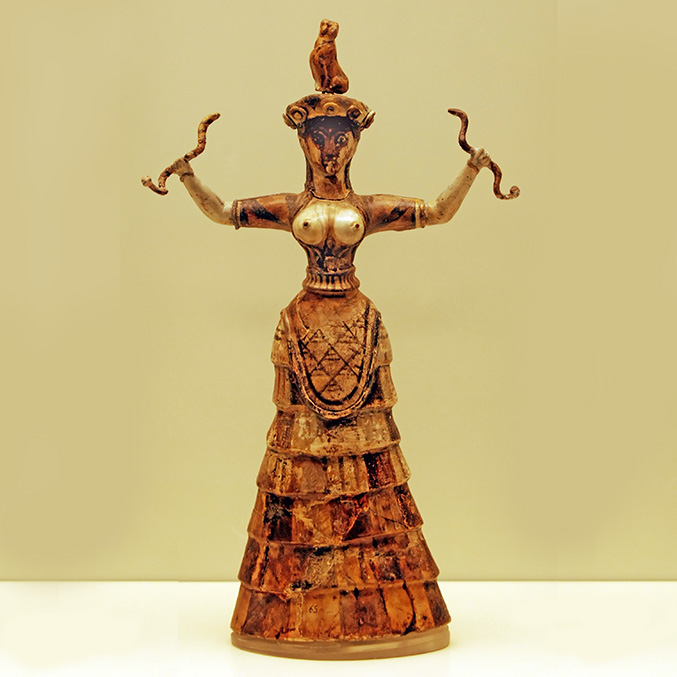Minoan Snake Goddess
EXCERPT:
You may also have heard of the Eleusinian Mysteries—secret rituals in ancient Greece that used a mind-altering mixture of unknown psychoactive plants, called kykeon, as part of their initiation rite. The Eleusinian Mysteries derived from earlier indigenous—and animist—Greek beliefs that were later adopted by the more familiar Hellenic Greeks. “In the early Greek spirituality there was no separation from nature,” Zoe Helene, founder of environmental feminist collective Cosmic Sister and a descendent of indigenous Greek Minoans and Mycenaeans, tells DoubleBlind. “Places, objects, elements and all living beings had a spiritual essence.”
Many of the animistic beliefs of the Minoans and Mycenaeans made it into the Hellenic pantheon only to then be appropriated by the Romans, whose culture was more materialist and patriarchal. Before this, the Minoan and Mycenaean religions were distinctly feminist and shamanistic. Early Greek rituals were largely female-led, and goddesses frequently practiced shape-shifting and journeying through mystic realms:
“Minoan medicine women are depicted with sacred snakes, cats, birds and more,” says Helene, noting that in the later Hellenic pantheon, most goddesses have sacred animals and many can become them: Athena, for example, can shape-shift into an owl, while both Hekate, goddess of crossroads, and Artemis, the daughter of a wolf, can transform into a bear and a cat. “Persephone travels back and forth from Gaia’s surface to Hades, the Underworld—which is not ‘hell,’ but rather a realm for souls in transition,” she adds. “Most goddesses have sacred plants and elements (fire, water, earth, air), too.”
Helene suggests that the loss of animistic traditions was linked to the more patriarchal and colonizing culture that first appeared in late-stage Hellenic Greece, and then became more destructive and excessive in Rome. This is aptly reflected in the shifting popularity of the deity Dionysus. Associated with altered states, ritual madness, and death-and-rebirth through estatic revelry, Dionysus had a powerful and positive reputation among the Greeks. Yet there were consequences to his promotion: “Dionysus rose from the ranks of an immortal demi-god [in Hellenic Greek mythology] to demand a seat at the table on Mt. Olympus,” Helene says.
Being the 13th member at a 12-seater table that was divinely gender-balanced, someone had to leave to make space. “This ended up being Hestia, an ancient and essential goddess of home and hearth, who embodies Center,” she continues. “It got to the point where citizens were abandoning day-to-day responsibilities to worship Dionysus by participating in his festivals. Chaos ensued and soon the Greek empire fell to Rome.”
In other words, the Ancient Greeks changed their relationship to sacred medicines. Where plants like the poppy, syrian rue, ergot fungus, and the mysterious kykeon had previously been allies for animistic ritual and healing, they now shifted towards recreational and excessive use. As Roman society focused on conquering the lands around them, rather than maintaining ecological balance, the connection to nature gradually slipped away.
Patrick Smith (PhD) is a former neuroscience researcher who currently writes about psychedelic science and culture. You can find his writing at thepsychedelicscientist.com.
